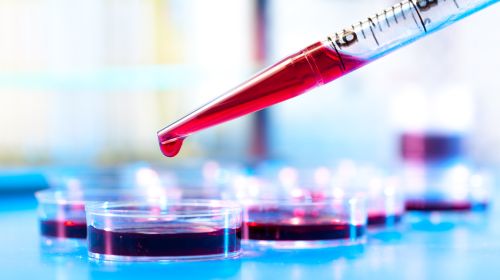The hematocrit value provides information about the proportion of all solid blood components in the total blood volume. The value measures how thin or thick the blood is.
- The blood sample is centrifuged in the laboratory to determine the hematocrit value. The relation of the solid to the liquid part is given as the hematocrit value in percent.
- © iStock.com/baytunc
Since red blood cells (erythrocytes) make up more than 95 percent of blood cells, the hematocrit value primarily shows their proportion in the blood. The laboratory value can also be used to determine how the patient's fluid balance is doing.
Article content at a glance:
When and how is hematocrit in the blood determined?
The hematocrit (abbreviations are Hkt, Hct or Hk) can often be found in laboratory results. It is one of the parameters that are measured as standard in the laboratory in the small blood count, for example during preventive examinations. Even if some diseases are suspected, the Hct is also determined.
For this purpose, whole blood is usually taken from the patient's vein. The sample is treated with an anticoagulant and centrifuged in a tube. The solid components (erythrocytes, leukocytes, thrombocytes) are clearly visible from the blood plasma. The sedimentation value is determined in a similar way, except that the blood is not processed mechanically, but has to separate into solid and liquid parts on its own.
Normal hematocrit value: what range is it in?
The height of the solid components in the tube is measured and set in relation to the total height of the blood sample. The reference value for the hematocrit is given in percent: In men, the hematocrit value is between 40 and 49.4 percent within the normal range. It is lower in women and is classified as normal between 36.6 and 44 percent.
Hematocrit too high? Causes of elevated values
A high hematocrit value can be dangerous to health in the long run: the more viscous the blood, the more the heart has to work to supply the organs. Thick blood flows more slowly and increases the risk of thrombosis and stroke.
If the hematocrit value is above the norm, doctors speak of a polyglobulia. The number of erythrocytes (red blood cells) or the concentration of hemoglobin (red blood pigment) is too high. The causes are manifold.
The proportion of red blood cells can increase when there is a lack of oxygen due to lung diseases or smoking. If you stay in high altitude air for a long time, your body produces more red blood cells to compensate for the lower oxygen content in the air you breathe. The hematocrit can rise to values of 70 percent, whereby the body naturally "dilutes" the blood at the same time. Competitive athletes who prepare for competitions in high altitude camps take advantage of this effect: the body produces more red blood cells and is more productive.
Illegal blood doping has the same effect: The hormone EPO (erythropoietin) is added, which stimulates the formation of erythrocytes. However, the high proportion of red blood cells increases the hematocrit value and thus the risk of blood clots.
The hematocrit is also increased when the body loses fluid: the blood then also contains fewer liquid components (blood plasma) with the same amount of red blood cells – the ratio of solid to liquid blood components increases. Loss of fluid occurs, for example, with profuse sweating, diarrhea or abnormally high urine excretion, as occurs in a special form of diabetes, diabetes insipidus.
In order to reduce increased Hct values to the normal value, fluids must be added. This happens in the case of dehydration, for example by giving a saline solution or drinking a lot.
Hematocrit Too Low: Symptoms and Causes
A lowered hematocrit is not as serious in terms of health as an increased value: the blood is thin and the risk of thrombosis is low. However, a low value indicates that the proportion of red blood cells is too low in relation to the whole blood.
The oxygen supply to the tissue is not optimal – signs of this are, for example, blue lips, paleness and fast freezing of fingers and toes.
The hematocrit is too low, for example, in anemia, but also in diseases that are associated with overhydration of the body. These include, for example, kidney weakness, hypothyroidism and heart failure.
Even if a patient is given replacement solutions to balance fluids over a longer period of time (for example during intensive medical treatment), the hematocrit is often below the reference value.
After major blood losses (operations, injuries), the hematocrit is initially within the normal range because solid and liquid blood components are lost in the same ratio. The body then first compensates for the loss of fluid in order to regulate the volume of the blood – the Hkt value drops. Only after a while, when the production of red blood cells has started, does the hematocrit rise again and reach normal values.


